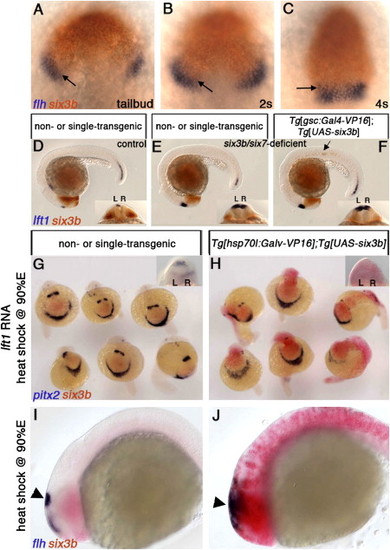
Six3 Function Is Required in the Neuroectoderm to Repress Diencephalic Nodal Activity (A?C) Wild-type embryos at tailbud (10 hpf) (A), 2s (B), and 4s (C) stages, labeled for six3b and flh expression, which marks presumptive epithalamic and dorsal telencephalic tissues. Overlap between six3b and the flh-positive domain is indicated by arrows. (D?F) Embryos from a cross between six3bvu87/+;Tg[gsc:Gal4-VP16]vu160 heterozygous and six3bvu87/+;Tg[UAS-six3b]vu156 heterozygous fish. Control embryo (D) not injected with MOsix7. (E and F) six3b/six7-deficient embryos. Only the embryo in (F) carries both transgenes, as evidenced by ectopic six3b in the notochord (arrow). (G and H) Embryos from a cross between Tg[hsp70l:Gal4-VP16]vu22 and Tg[UAS-six3b]vu156 heterozygous fish that were injected with lft1 RNA and heat-shocked at late gastrulation (H). (I and J) Ubiquitous six3b does not eliminate presumptive pineal tissue (flh-positive domain, arrowheads in [I] and [J]). R, right; L, left. (A?C) Dorsal views, anterior up. (D?F, I, and J) Lateral views, anterior to the left. Insets in (D)-(H) are dorsoposterior views.
|

